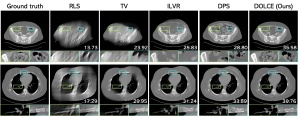by
John R. Fischer, Senior Reporter | October 13, 2023

DOLCE can reconstruct low-angle CT images, despite missing and limited datasets.
Because of its speed, low radiation exposure, and advantages in specific applications, low-angle CT is a commonly used technique, often applied in emergency or critical care cases, dental cone beam CT, or when patients have trouble holding their breath. But it has its drawbacks, namely incomplete data sets, which often result in artifacts and discrepancies that reduce the accuracy of scans, even when they are reconstructed with AI.
To address these limitations, engineers at Washington University in St. Louis and researchers at the Lawrence Livermore National Laboratory developed and tested DOLCE, a deep learning model-based framework that uses generative AI to produce multiple high-quality images from severely limited data. They compiled their findings in a study, “DOLCE: A Model-Based Probabilistic Diffusion Framework for Limited-Angle CT Reconstruction,” which they discussed this month at the International Conference on Computer Vision (ICCV) in Paris.
DOLCE stands for diffusion probabilistic limited-angle CT reconstruction, and unlike traditional generative AI models, such as large language model chatbots, it uses AI to reconstruct images, but also quantifies its reconstruction uncertainty, including for the type of measured data it uses and the physical properties of the underlying system. It also creates a variance map to show the different alternative reconstructions it could have produced with the available data.



Ad Statistics
Times Displayed: 174433
Times Visited: 3180 For those who need to move fast and expand clinical capabilities -- and would love new equipment -- the uCT 550 Advance offers a new fully configured 80-slice CT in up to 2 weeks with routine maintenance and parts and Software Upgrades for Life™ included.
“We are developing a new reconstruction framework that can efficiently incorporate a 3D CT physical measurement model in order to more effectively enhance data consistency,” said Jiaming Liu, a doctoral student in electrical and systems engineering, and Ulugbek Kamilov, an associate professor of electrical and systems engineering and computer science and engineering in the McKelvey School of Engineering at Washington University in St. Louis, in a statement.
Kamilov and Liu applied the solution to a kidney and kidney tumor data set containing 3D CT images of 210 patients. They recovered high-quality CT images that preserve the geometric structure and sharp edges, and found that DOLCE could incorporate different types of images into its diffusion model for image reconstruction. It also demonstrated state-of-the-art performance on diverse data samples, including images of the human body and checked-in luggage, making it a versatile method for LACD reconstruction in and outside of healthcare.
While Kamilov and Liu say it is not specifically designed for medical diagnostics, it provides a realistic view of a patient’s condition and what variations are possible with the images it generates. The refinements being made are meant to make it more applicable for medical imaging.
“We are also designing new generative AI architectures for better 3D CT data representation ability,” said Kamilov and Liu.

